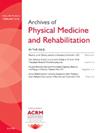用剪切波弹性成像法测量冈下肌潜在触发点及周围区域的僵硬度:检查者内部和检查者之间的可靠性分析。
IF 3.7
2区 医学
Q1 REHABILITATION
Archives of physical medicine and rehabilitation
Pub Date : 2025-09-01
DOI:10.1016/j.apmr.2025.03.036
引用次数: 0
摘要
目的:探讨剪切波弹性成像(SWE)在测量肌下肌潜在肌筋膜触发点(MTrPs)和健康周围区域的刚度、压痛阈值(PPT)、检查人之间的信度以及MTrPs和控制点之间SWE和PPTs的平均差异方面的检查人内部和检查人之间的信度。剪切波弹性成像(SWE)是一种客观的方法,可替代手工触诊等高度主观但可靠性较差的方法。纵向观察研究:内测者和内测者的信度研究。环境:大学实验室。参与者:40名冈下肌内潜伏mtrp的参与者。干预措施:没有。主要结果测量:一位经验丰富的检查人员识别和分类潜在的mtrp,并在冈下肌内选择一个无症状控制点。随后,2名盲法审查员对PPTs进行一次评估(对分数不知情),并获得每个位置的2张SWE图像。计算信度估计以评估PPT内部和SWE内部和内部的信度。PPT和SWE评分按位置(MTrP和对照组)和性别(男/女)进行比较。结果:与对照组相比,男性(p=0.003)和女性(p=0.006)的MTrPs的PPTs明显降低,女性(MTrP p0.84)和SWE (ICC>0.82)均明显降低。在新手和有经验的审查员中,SWE的内部信度都很好(ICC>0.95)。结论:本研究显示良好的SWE考官内信度(ICCs>0.9)和良好的考官间信度(ICCs>0.82)。虽然PPT评分显示潜伏mtrp和控制点之间的高易怒性有显著差异,但SWE测量显示肌肉僵硬度没有显著差异。本文章由计算机程序翻译,如有差异,请以英文原文为准。
Shear Wave Elastography for Measuring the Stiffness of Latent Trigger Points and Surrounding Areas in the Infraspinatus Muscle: Intra- and Interexaminer Reliability Analysis
Objectives
To explore the intra- and interexaminer reliability of shear wave elastograhy (SWE), (an objective alternative to highly subjective procedures with poor inter-rater reliability such as manual palpation) in measuring the stiffness of latent myofascial trigger points (MTrPs) and healthy surrounding areas in the infraspinatus muscle, pressure pain threshold (PPT), interexaminer reliability, and mean differences in SWE and PPTs between MTrPs and control points.
Design
Longitudinal observational study: Intra- and interexaminer reliability study.
Setting
A university laboratory.
Participants
Forty participants (N=40) with latent MTrPs within the infraspinatus muscle.
Interventions
Not applicable.
Main Outcome Measures
One experienced examiner identified and classified latent MTrPs and selected an asymptomatic control point within the infraspinatus muscle. Later, 2 blinded examiners assessed once the PPTs (blinded to the scores) and acquired 2 SWE images of each location. Reliability estimates were calculated for assessing PPT interexaminer reliability and SWE intra- and interexaminer reliability. PPT and SWE scores were compared by location (MTrP and control) and gender (male/female).
Results
PPTs were significantly lower in MTrPs than control points in males (P=.003) and females (P=.006), and lower in females than males (MTrP P<.001; control point P=.001). Good interexaminer reliability was found for PPTs (intraclass correlation coefficient [ICC]>0.84) and SWE (ICC>0.82). Intraexaminer reliability for SWE was excellent (ICC>0.95) in both the novice and experienced examiners.
Conclusions
This study demonstrated excellent SWE intraexaminer reliability (ICCs>0.9) and good interexaminer reliability (ICCs>0.82). Although PPT scores indicated significant differences in hyperirritability between latent MTrPs and control points, SWE measurements revealed no significant differences in muscle stiffness.
求助全文
通过发布文献求助,成功后即可免费获取论文全文。
去求助
来源期刊
CiteScore
6.20
自引率
4.70%
发文量
495
审稿时长
38 days
期刊介绍:
The Archives of Physical Medicine and Rehabilitation publishes original, peer-reviewed research and clinical reports on important trends and developments in physical medicine and rehabilitation and related fields. This international journal brings researchers and clinicians authoritative information on the therapeutic utilization of physical, behavioral and pharmaceutical agents in providing comprehensive care for individuals with chronic illness and disabilities.
Archives began publication in 1920, publishes monthly, and is the official journal of the American Congress of Rehabilitation Medicine. Its papers are cited more often than any other rehabilitation journal.

 求助内容:
求助内容: 应助结果提醒方式:
应助结果提醒方式:


